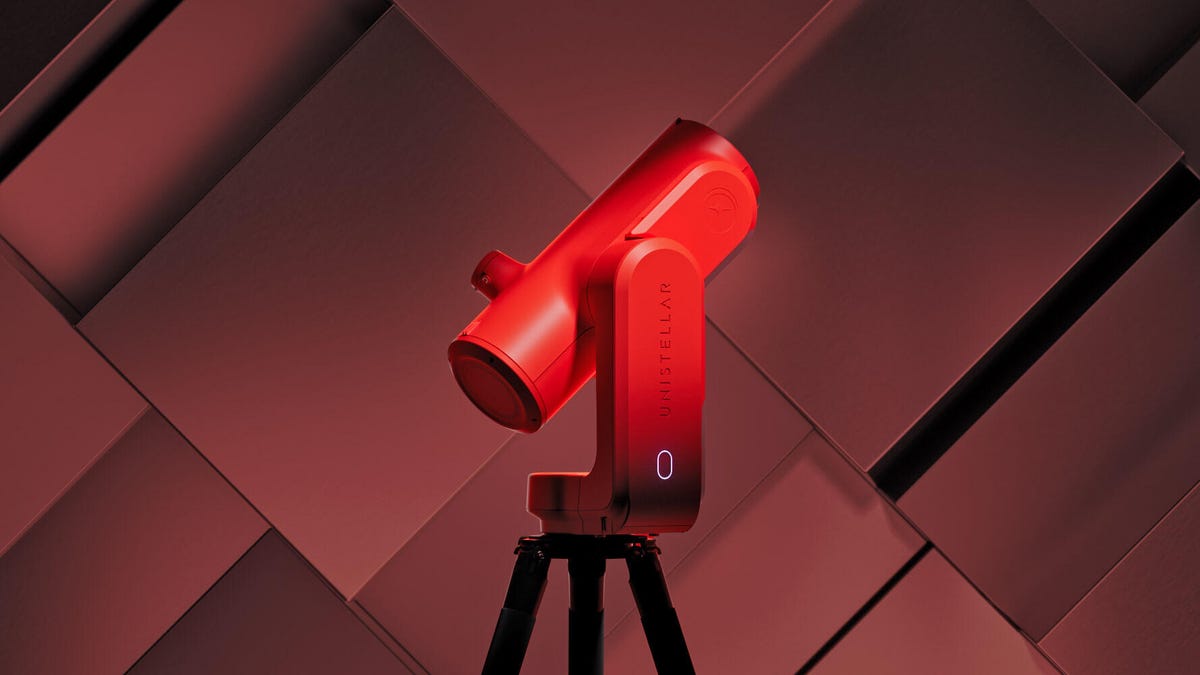 Why You Can Trust CNET
Why You Can Trust CNET Unistellar's 2nd-Gen Digital Telescopes Reveal the Heavens With Faster Focus
The Odyssey and Odyssey Pro telescopes, announced at CES, are designed to take the hassle out of amateur astronomy.

The Unistellar Odyssey Pro digital telescope is on sale now, but a special red edition goes on sale in April.
I was impressed with Unistellar's EVScope 2, a digital telescope that steers itself toward the stars, nebulas and galaxies that you select with the associated app. Now the company has lower-priced second-generation products, the Odyssey and Odyssey Pro, that take care of another hassle of gazing at the heavens: focus.
The Odyssey models, announced Sunday at CES Unveiled and on sale now, use their own smarts to lock in focus on astronomical objects. That addresses one of the most tedious aspects of their predecessors: the need to use a special screen to manually focus the telescope — and refocus it as dropping night temperatures shrank the telescope and knocked focus out of whack.
"This is basically the telescope that solves most of the issues we have with gen one," Franck Marchis, a SETI Institute astronomer and Unistellar's chief scientific officer, said in an interview.
At $2,499 for the Odyssey and $3,999 for the Odyssey Pro, the new models aren't going to be a casual purchase for most of us. But they're a step down in price from the $4,899 EVscope 2 that I tested, and for astronomy enthusiasts or educators this kind of product can make the marvels of the universe much more accessible.
Unistellar's telescopes work by analyzing the pattern of stars they're pointed at to figure out their orientation. With an app, you can then pick from a long list of astronomical objects and the telescope will slew around to find them. And in contrast to the fiddly motors that traditional telescopes use to counteract the Earth's rotation, Unistellar telescopes just keep track of what they're observing and steer accordingly.
They're digital cameras, so they can take photos, too. The telescopes stack multiple images together for a better final photo. It's no James Webb Space Telescope, but even in suburban skies with some light pollution, I was able to capture photos good enough to give me a sensation of, "Wow, I'm looking at another galaxy millions of light years away, and it's just right up there in the sky."
Unistellar's Odyssey and Odyssey Pro digital telescopes can photograph the moon and astronomical objects like the Dumbbell Nebula.
The Odyssey and Odyssey Pro models add automatic autofocus, which eliminates a big hassle and helps avoid soft focus that spoiled some shots I tried to take with the EVscope 2. They're also smaller and lighter, weighing less than half the EVscope 2's nearly 20 pounds.
With a pixel binning technology called Multi-Depth, the Odyssey Pro also automatically optimizes photos for different situations, offering higher resolution for relatively bright planets in our own solar system and better low-light performance with more distant, dimmer objects. And for bright objects in the solar system, it can combine the best of many shots taken with very fast shutter speeds to counteract blur from atmospheric distortion.
The Odyssey Pro also has an optical viewfinder; you can only see the stars on the Odyssey using the app. A special red version of the Odyssey Pro, more expensive at $4,499, is due in April.
Unistellar will continue to sell the EVscope 2, which offers slightly better performance for viewing dim objects thanks to its wider aperture for gathering more light.
"The EVscope is for amateur astronomers who truly know about telescopes," Marchis said.

